Adaptation of Plants and Animals to their Habitat
What would happen if a polar bear is brought to a desert? It may not survive. That is because a desert is very hot and the polar bear is not suited to live there. It’s natural habitat is the polar region, which is a very cold place.
Habitats differ in several ways. Some are hot whereas some are very cold; some receive a lot of rain while some are very dry; some are hilly areas while some are plains. Because each habitat is different, animals and plants found in a particular habitat have changed or adapted themselves to survive there. For example, a polar bear is adapted to live in polar regions.
Changes in the structure or behaviour of an organism that allow it to survive in a particular habitat are called adaptations. Adaptations in organisms take place gradually, over thousands of years.
Generally, organisms adapt to their habitat by the following means:
- Changes in body. Many plants and animals develop special body parts that help them to survive in their habitat. These changes are termed modifications.
- Changes in behaviour. Many organisms show specialized behaviour to survive in their habitat. For example, some animals reduce their activities during winter months and go to a ‘deep sleep’ to deal with extremely low temperatures. The period of reduced activity in animals during winter months is known as hibernation.
- Changes in location: Certain animals (e.g., some birds and fish) move from one region to another in response to climatic changes. The seasonal movement of animals from one region to another in search of warmth and food is called migration.
Adaptations for Tropical Forests (Rainforests)
Plants: Following are some adaptations shown by rainforest plants.
- Leaves of tropical rainforest trees have specialized tips, called drip tips. Drip tips enable raindrops to run off quickly, without allowing them to stick to leaf surface. This protects the leaves from rotting.
- Due to the dense vegetation of rainforests, very little light is able to reach the forest floor. Thus, very few plants are able to survive on the rainforest floor. Some plants have adapted in this habitat by climbing onto the trunks of nearby trees to reach the sunlight. Plants growing in lower levels have big leaves to absorb as much sunlight as possible.
Animals: Animals in rainforests show the following adaptations:
- There is a huge variety of animals found in rainforests. Therefore, the competition for food is very high. Many animals have adapted by learning to eat a particular food, which is eaten by no other animal.
- The sloth exhibits camouflage. The ability of certain animals to blend with the surroundings, making them difficult to spot is called camouflage. This adaptation enables them to hide from predators. Leaf insects and stick insects also show camouflage.


Adaptations for Temperate Forests
Plants: Following are the adaptations shown by plants in temperate forests:
- Most trees are deciduous. They have thin, broad leaves that allow them to easily capture sunlight, which is required for making food.
- Broad leaves are not able to bear the freezing winter and can get damaged easily. To prevent damage, trees shed their leaves during winter.
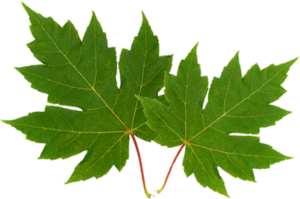
Maple leaf
Animals: Animals in temperate forests show the following adaptations:
- Many animals either hibernate or migrate to warmer regions during winter.
- Animals like squirrels and chipmunks gather food during summer and store it for eating during winter, when food is scarce.
Adaptations for Boreal Forests
Plants: Following are the adaptations shown by plants in boreal forests:
- Boreal forests receive heavy snowfall. Trees have a conical shape which allows the snow to slide off easily.
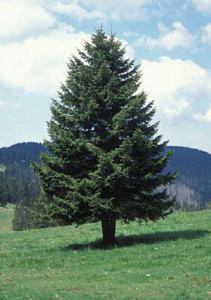
Trees are conical shaped - Most trees found in boreal forests are evergreens. Trees have narrow, needle-like leaves.This kind of structure protects the leaves from damage.
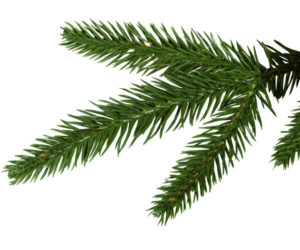
Needle like leaves of pine - Growing new leaves requires a huge amount of energy. The soil found in boreal forests does not contain many nutrients. Also, these regions do not receive much sunlight. Boreal forest plants are able to conserve energy by not shedding their leaves. They also avoid growing new leaves.
- Boreal forests are so cold that the ground freezes during winter months. Because of this, the trees are not able to get water. Narrow, needle-like leaves of these trees help to conserve water.
Animals: Animals in boreal forests show the following adaptations.
- Most boreal animals migrate to warmer regions during winter. Some animals hibernate during winter months.
- Some animals have a thick layer of fur or feathers to protect themselves from cold.
Adaptations for Grasslands
Plants: Following are the adaptations shown by plants in grasslands:
- Grassland plants usually have flexible stems, which bend instead of breaking when the wind is strong. These plants also have strong roots that prevent winds from uprooting them.
- Plants have narrow or tiny leaves to reduce water loss. The baobab tree can survive periods of low water availability by storing water in its huge trunk.
- Some plants have roots that extend deep into the soil to absorb as much water as possible. This also prevents grazing animals from pulling the roots out. Long roots of the acacia tree allow it to access water that is very deep in the ground.
Animals: Animals in grasslands show the following adaptations:
- Most grassland animals are able to run very fast (e.g., gazelles and zebras), which allows them to escape their predators. This ability also protects them from frequent grassland fires. Small animals survive the fire by digging themselves underground.
- The grasses found in dry grasslands are brown in colour most of the times. Many grassland animals have skin shades of brown, which makes them hard to spot among the dry, brown grass.
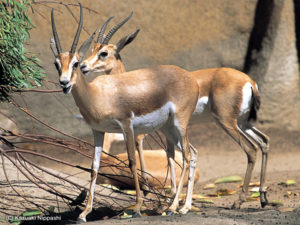
Gazelles are brown in colour
Adaptations for Deserts
Plants: Plants have developed adaptations to survive in the hot and dry climate of the deserts. Most plants have long roots that go deep into the soil in search of water.
A cactus has the following modifications:
- The leaves are modified as spines to minimize water loss.
- The stem is green, to make food for the plant.
- The stem is swollen and fleshy to store water.
- Cactus has a thick, waxy coating that prevents water loss and helps it to retain water.

Cactus has spines to prevent loss of water
Animals: Desert animals have adapted themselves to live in their habitat in the following ways.
- Camel’s long eyelashes and ear hairs protect the eyes and ears from sand.
- Fat stored in a camel’s hump acts as a food reserve.
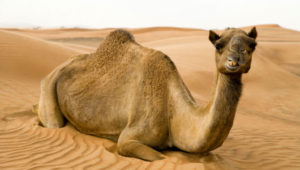
A camel’s hump stores fat - Its long legs keep its body away from hot sand.
- Broad feet help in walking on the sand without sinking in it.
- It can drink a huge quantity of water at a time and can stay without water for a long time. Its body loses very little water in the form of urine.
- It can keep its nostrils closed to keep out sand.
- Many desert animals and insects stay in deep underground burrows during the day to escape from heat, e.g., the kangaroo rat.

The kangaroo rat - It does not drink water. It gets all the water it needs from its food (mostly seeds). The oxygen that it take in combines with food to produce water inside the body.
Adaptations for Mountains and Polar Regions
Plants: Plants in these regions have adapted themselves in the following ways.
- Mountain plants grow close to the ground to avoid being uprooted by strong winds.
- Also, these plants produce smaller leaves to prevent water loss.
- Some plants are also able to grow under a layer of snow.
Animals: Animals in the mountains show following adaptations;
- Some mountain animals hibernate or migrate to warmer areas during colder months.
- The polar bear has several adaptations to survive in the polar regions. White fur matches the surroundings (snow) making the polar bear difficult to spot.
- Small ears and tail minimize heat loss from the body.
- Padded feet help the polar bear to walk on the snow.
- Thick fur and a layer of fat under the skin protect the polar bear from cold.

A polar bear has several adaptations to survive in extreme cold. - The yak has several adaptations to survive in the mountains. The yak’s mouth is adapted for grazing on a variety of plants.
- Thick coat of hair protects the yak from cold.
- Large chest and lungs are adaptations to low oxygen content in the mountains.
- The yak uses its hooves and horns to break the ice from frozen ground and graze on the grass below.
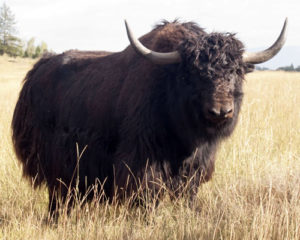
OLYMPUS DIGITAL CAMERA The yak’s body is covered with a thick layer of hair.
Adaptations for Aquatic Habitat
Plants: Freshwater plants show the following adaptations.
- Plants that live in flowing water have long, narrow stems. This prevents the plants from being carried away with water currents.
- Stems have air chambers that allow the aquatic plants to float in water.
- Leaves of plants like lotus and water lily have a waxy covering that prevents them from rotting.

Leaves have a waxy coating that makes them waterproof.
Animals: Aquatic animals show a variety of adaptations to survive in water.
- Ducks have webbed feet that help them in swimming. They also have hollow bones that help them to stay afloat. Oil produced from under their tails makes their feathers waterproof.
- Fish have the following modifications to live in water. Gills are special organs that help fish to breathe underwater.

Fish swim in water. - Fins help them to swim and maintain the body balance.
- Their streamlined body allows them to swim fast by reducing resistance due to flowing water. Some sea animals like octopus and squid do not have streamlined shape. However, while they move in water, they make their body streamlined.
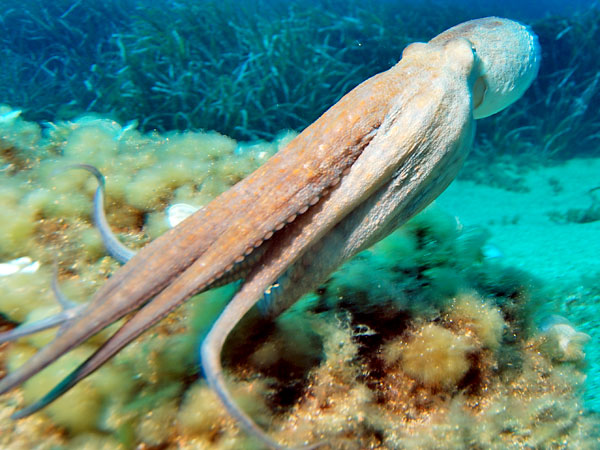
Octopus takes streamlined shape when it moves in water
- Animals like dolphin and whale do not have gills to breathe in water. They have blowholes located at the upper parts of their heads. They come to the water surface and breathe in air through the blowholes from time to time. This allows them to stay under water for a long time.

A whale leaping out of water
Acclimatization
Adaptations refer to changes in an organism over a long period of time. There are certain changes that can occur in an organism over a short period of time, which help the organisms adjust to the changes in its surroundings. This is called acclimatization. For example, sheep grow very thick wool in cold climates. Another common example of acclimatization is altitude sickness. Many people (who live in the plains) suffer from altitude sickness when they go to high mountains, where there is low oxygen content. They feel breathless and nauseous. However, their body adjusts to the changes in a few days. They acclimatize to the changes in the surroundings. For this reason, high altitude climbers often stay a few days at a base camp and then climb up slowly to a higher camp. Thus, adaptation is different from acclimatization.
